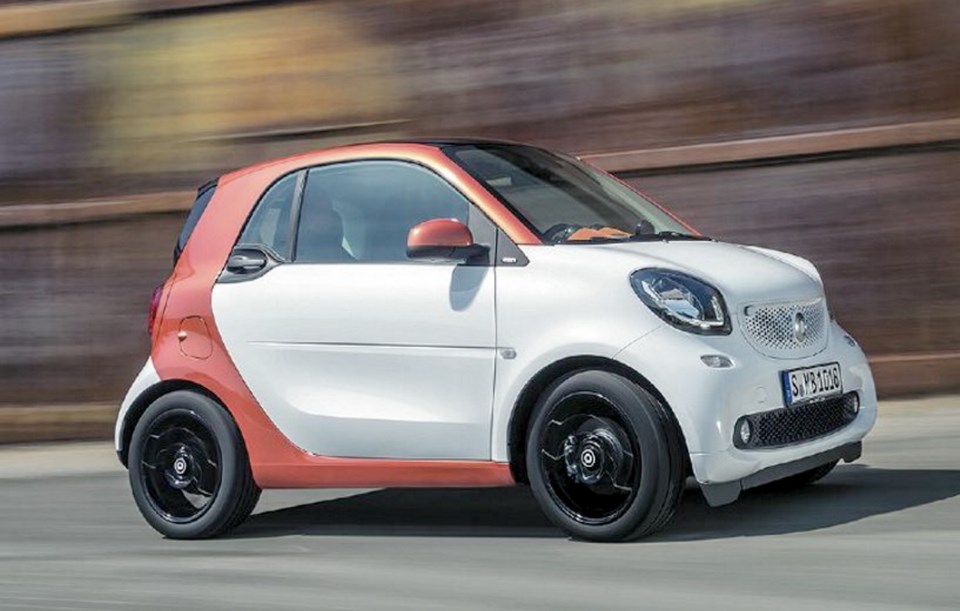Wheelbasemedia.com
Completely redesigned for the 2016 model year, Mercedes-Benz’s Smart Fortwo is more clever and efficient, with a broader world view that should boost its popularity, particularly in North America. Built on a new platform co-developed with French automaker Renault, the Fortwo retains its rear engine, rear-wheel-drive layout, looking less toy-like on the outside and completely different inside, with a rounded instrument panel, new centre console and a five-centimetre wider body and more interior space. More power comes from a turbocharged three-cylinder gasoline engine but perhaps more critically a new, better-shifting six-speed paddle-shift automatic transmission. Expect it to deliver better efficiency.
Korea deal explores electric-car options: Wannabe electric sports car manufacturer Detroit Electric has signed a memorandum of understanding with Integrated Energy in South Korean to buy 300 of its vehicles for sale on Jeju Island in South Korea starting in the first quarter of 2015. Jeju Island, with the most comprehensive electric vehicle-charging infrastructure in South Korea, seeks to become a zero-car-emissions zone by 2020. The companies also said they will join forces in a pilot program to develop vehicle-to-grid, vehicle-to-home and vehicle-to-vehicle systems in the daily operations of a fleet of Detroit Electric vehicles. An interesting feature will allow the cars, and their used batteries, to be used as power sources for both the electrical grid and homes.
Aluminum leads vehicle-weight-loss efforts: BMW’s flagship 7 Series luxury sedan is in for an accelerated weight loss program, using lessons learned from the development of its i3 electric car and i8 plug-in hybrid sports car. British magazine Autocar says the use of aluminum, magnesium, high-strength steel and carbon-fibre-reinforced plastics could cut the limo’s weight by as much as 200 kilograms, bringing a model like the 740i down to just over 1,600 kilograms, or less than the smaller 535i sedan. That echoes the work done at Jaguar, whose aluminum-formed XJ luxury sedan is lighter than the smaller XF model in some variants, notes alternative vehicle website Green Car Reports. Other automakers are also using more aluminum to reduce weight in their larger vehicles.
Small engine delivers big performance: Volvo has developed a turbocharged 2.0-litre four-cylinder gasoline engine that cleanly delivers an astonishing 450 horsepower. The aim, said head of research and development, Peter Martens, was to deliver “the most advanced four-cylinder engines in the industry” based on emissions and fuel consumption relative to performance and drivability. Using “triple boost” technology developed with partners, Volvo said the compact size improves weight distribution and lowers the vehicle’s centre of gravity. Volvo’s development of the concept engine is part of an ongoing process that aims to reduce emissions without compromising performance. Compact powertrains free up space and weight in the structure of a car, which can be used for electrification and even further emissions reduction, “and that is our ultimate ambition.”
Ford finds focus in recycled fabrics: Ford claims to be the first automaker to use fabrics made of recycled materials in vehicles sold around the world. The automaker has increased the use of recycled yarns from zero in 2007, to nearly 66 per cent of all its vehicle programs in 2013. Overall, Ford uses 41 fabrics across 15 vehicle lines globally, from Mustang and Fiesta to the F-150 and Taurus sedan. According to Carol Kordich, lead designer of sustainable materials, the idea is to one day have all Ford fabrics consist of recycled materials; Ford’s compact Focus shows the goal is attainable, she said. Since the 2009 model year, any new seat fabric used in Ford vehicles must contain at least 25 per cent recycled materials.
GM may put Spark in high-mileage electric car: Is General Motors’ long-rumoured 300-kilometre-plus EV about to break cover? Auto industry watchdog Automotive News quotes undisclosed sources within GM as saying Chevrolet’s subcompact Spark runabout would be that car, and that it will bow some time in 2017.
